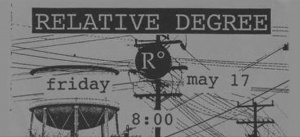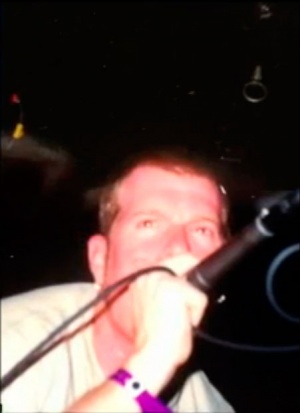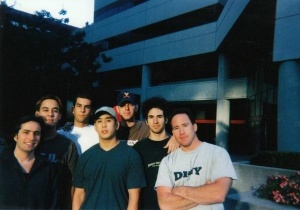Background
When Mike Shinoda was 15, a friend’s dad chaperoned them to a Anthrax and Public Enemy show[1] during Anthrax' Attack Of The Killer B's tour in 1991.[2] He was so inspired by the musical melding that when he decided to form his own group, he wrote with both rhymes and rhythms in mind.[3]
Mike took piano lessons for about 13 years, starting when he was about 6 years old. At this age, he ended up wanting to go in a direction (hip hop / production, jazz, blues) that his teacher, Eileen, wasn't familiar with, so he left. He bought some production equipment (a keyboard and then a sampler with the help of Styles Of Beyond's producer Vin Skully)[4][5] and started making beats and playing with MIDI and digital-based music.[6] The beats were inspired by old-school rock & roll or blues songs and he eventually started rapping over them. For the most part, he made a lot of Gangsta rap joke songs, resulting in a demo tape called Pooch Pound.[7]
When he was 8 or 9 years old, Rob Bourdon and his brother used to play along to Aerosmith and Faith No More on their parents couch with a pair of drumsticks.[8] Later his brother got a drum kit and Rob started playing piano. When he was 12, he started taking drum lessons and switched to playing drums full time. He was inspired to play the drums after his mom took him to an Aerosmith concert and introduced him to Joey Kramer (Arosmith's drummer).[9] In 6th grade Rob started playing in a band with 3 friends called No Clue, that would play cover songs. In 7th grade they switched their name to Physical Evidence and covered Nirvana, Bad Religion and Suicidal Tendencies. When they started writing their own original music, the songs sounded like a blend of those 3 different artists, with most of the lyrics being about the teachers they hated in their junior high school. When he was in the 10th grade his parents made him[10] join in his high school's jazz band (the Calabasas High School Jazz Band). He played one show and didn't like it, but in the audience two musicians who were contemplating forming a new band saw Rob performing and recruited him to audition for their new band called Karma. Through the bass player of Karma he met Brad Delson and Mike Shinoda who both lived nearby in the San Fernando Valley.[11]
Brad has been interested in music as far back as he can remember. He played trumpet in his elementary school orchestra, and started learning to play guitar when he was 12 or 13, taking lessons for about 5 years before he started teaching guitar and playing with friends in local bands.[12] He was neighbors with Mark Wakefield in highschool and the two of them were in a band called The Pricks.[13]

Mark,[14] Brad and Rob, along with the bass player from Karma then started a band called Relative Degree. They had a dream of playing one show at The Roxy Theatre, a popular club for up and coming bands located on Sunset Blvd. in West Hollywood, California, so they set it as their big goal. The band wrote 12 songs and rehearsed for a year before playing the show at The Roxy[15] which finally happened on May 17, 1996.
Brad said, "People laugh at me when I say this but my goal was - as a musician - to play a show at our local club, the Roxy, in L.A. in high school for my friends. I did it. Now I say this, and it may sound like bullshit, everything that's happened from that point on is all gravy. We're really proud of the music we've made, and for everyone that gets to hear it, that's more love for us. We're totally happy."[16]
Although Mike never joined the band, he would occasionally put samples into their songs and watch them practice, and developed a strong friendship with Brad when they were both in 8th grade.[17]
Still in his development stage of rapping, Mike used to do demos with Ryu of Styles Of Beyond in his bedroom.[18][19] He would later design Styles Of Beyond's original logo[20] and produce an unreleased version of "Marco Polo" for the album 2000 Fold.[21] He would also create album art for DJ Frane's Fantastic Boatride and Saukrates' The Underground Tapes as well as for the Styles Of Beyond album.[22]
Mike and Mark have been friends since they were 12 and used to make funny songs together.[23] When Relative Degree broke up after playing only one show,[24] they started a new band called "Xero". At that point, Mike was mainly doing beats for various hip hop acts (and for himself as well),[25] but decided he wanted to experiment with mixing different styles of music together.[26] The duo recorded a demo which would be sent out to record companies to try and get signed. They sent it to an indie label/publishing company (which was the only one they knew) and were called in. Their A&R person was shocked that they recorded a professional sounding demo on a 4-track in Mike's bedroom and encouraged them to put a band together and start playing shows.[27] After one or two writing sessions, they enlisted the help of Brad and set their first goal to play at the Whisky A Go Go.
Brad was in his first year of college, studying communications at the University of California, Los Angeles (UCLA), when he attended to a class taught by Jeff Blue, who had just signed Korn and Limp Bizkit. Jeff was also developing a young woman named Macy Gray and told everybody in the class he was looking for an intern to help build her career, and help him showcase artists, and Brad volunteered for the job. The next morning, Jeff walked in his office and his sister told him there was some kid waiting to speak to him, even though he had no appointments. He then saw Brad spinning on Jeff's seat. Jeff told Brad to don't ever sit in his seat again and asked him to talk about himself. He told Jeff about his dream of becoming a lawyer and about his band that he was developing. Brad then pointed to a big Limp Bizkit poster Jeff had in his office, which he was really proud of, and said "That band is not that great. I may have a band that's better than that." Jeff liked his confidence and hired Brad as his intern.[28] Funny enough, DJ Lethal of Limp Bizkit would later help Linkin Park by giving Mike music plugins, adive and sounds.[29]
After the end of Relative Degree, Rob went through a rough period in his life, struggling with drugs and alchool, and became isolated from everyone. Towards the end of high school, he got his life back on track and went back into playing drums full time again. Around that time, he got a call from Mike asking if he wanted to listen to some songs he had written with Brad and Mark. He was impressed by their work and became involved right away.
Dave Farrell studied philosophy at UCLA and was a college roommate of guitarist Brad. The duo were playing small jazz events together. Dave had been excited about the progression Brad had been making with his high school friends, so when the opportunity arose, he joined the band.
Since the begining, the band knew they would need a DJ in order to perform their songs live, but the DJ would need to be someone who could handle more than just scratches. Mike met Joseph Hahn when both were studying illustration at the Art Center College of Design in Pasadena.[30] They had similar interests and shared a love for music, especially hip hop. Joe went there for about a year before he started working in special effects and character design for storyboarding. A couple years after their initial meeting, Mike approached Joe about a project named Xero. Before joining the band, Joe had been busy doing conceptual design and animation for television and movies such as Phantom, Virus, Sphere, X-Files, and Dune. Like Mike and Dave, Joe had been a classically trained musician and brought new capacities for sounds to the band. Joe played violin in school for a few years and then played guitar for a bit before he started getting serious about DJ-ing in high school.[31] He says, "Around high school I loved music, hip-hop and all the stuff going on in KROQ back when people listened to the radio. I was DJing and I got into scratching and all that. The idea of a sound wave on a record and being able to manipulate it with speed and turning the volume up and down and having that turn into something totally different was really new and experimental at the time. I love the idea of just twisting sounds and manipulating beats; the idea of distortion and where that can go and how powerful sounds can be."[32]

They eventually made demo tape containing 4 songs which was passed out to friends and new fans.[33][34] There were two issues of the tape, both with the same tracks but different covers. The black and white shopping cart had fewer copies made and was actually a joke for a cover for the tape before the blue cover with the baby was made.[35]
Xero played their first shows as a band on the Sunset Strip in West Hollywood,[36] with the first one taking place on November 14, 1997 at the Whisky A Go Go, playing before SX-10 and System Of A Down. Mike said, "I remember that gig. I was wearing the most ridiculous thing ever. I had this white beanie hat on with blue goggles and white gloves, I think because it made me feel more like a performer and not the normal dude that I knew I was. So I had to get into costume in order to get psyched up and get into character. We were awful, just horrible but we survived."[37] The club was packed with A&R scouts that had all fled by the third song. However, Jeff Blue saw that the group had potential but were pretty far from actually "making it", so he gave them a development deal, with a little financial support from Zomba Music Group. Jeff said, "The place was empty. You could hear crickets."[38] With the help of a publishing company, the self-managed band was able to buy new instruments and equipment, get a decent recording and a better show.[39]
Mike said, "We would write a lot more than we played. A lot of bands rush their songs, and go out and play a ton of shows; we spent weeks and weeks on the music, and probably only played one or two shows a month." Dave added, "We definitely weren’t polished but we had a lot of potential. We only really played shows as an excuse to get our friends together for a party afterwards. In the early stages, it wasn’t about getting a record deal. But the more we played, the more we realised we might have a chance."[40] It was at one of those after show parties in February 1998 at Brad and Phoenix's apartment that Mark Wakefield introduced Mike to his friend Anna (Mike's future wife) from Long Beach.[41]
Xero played several shows after this to mostly empty venues with almost no one in attendance. The sets consisted of around six to eight songs and were 25-30 minutes. The public was mostly there just to support friends.[42] Local bands like Incubus, Hoobustank (now Hoobastank) and Xero would attend each other's shows.[43]
At some point in 1998, the band would go by the name "Xero 818",[44] 818 being one of the area codes for the San Fernando Valley area, which is where the band is from. By the end of the year, Mark left the band and joined System Of A Down's manager David "Beno" Benveniste on the Velvet Hammer Music and Management Group. Beno was also the founder of Streetwise, a marketing company which would later help Linkin Park building their street team.[45][46]
Dave would soon leave Xero too. He was also committed to another band, Tasty Snax, with whom he had been close friends with since high school. They released their debut album, Run Joseph Run, in 1998 and when they left on tour, Dave went with them.[47] They would release a second studio album, Snax, in 2000 and break up in the following year. Their vocalist, Mark Fiore, would later become Linkin Park's videographer.
Writing and Recording
The songs were mostly written by Mike Shinoda and Mark Wakefield from 1996 to 1997, with Brad Delson and Joe Hahn also being credited for "Rhinestone".
"Fuse" features a sample of "The Very Long Fuse", a story narrated by Laura Olsher on Disneyland Records' 1964 album Chilling, Thrilling Sounds Of The Haunted House.
On "Stick N Move", Mike did a reference to "Check The Rhime" by A Tribe Called Quest.
The demo was recorded in 1997 in a makeshift studio set up in Mike's bedroom. The songs were recorded on a little 4 track recorder without any live drums.
Composition
Other than the 4 tracks on the demo tape, Xero wrote and recorded more songs as a band.

"Rhinestone" was re-recorded at some point when Mark was still in the band and used on the soundtrack of the 20th episode of the Canadian TV show "The Crow: Stairway to Heaven", entitled "Brother's Keeper", which aired on May 7, 1999.[48] A soundtrack CD for the series exists but "Rhinestone" wasn't included in it.
On Hybrid Theory, "A Place For My Head" credits Mark Wakefield because the original incarnation of its demo, "Esaul", was written by Xero. Additionally, "Forgotten" was rewritten from Xero's "Rhinestone" and "Runaway" originated from elements of "Stick N Move". On the LP Underground 9: Demos album, a demo of "Stick N Move" was released with the date of 1998.
The unreleased song "Pictureboard" is listed on the BMI song database and credits Mark Wakefield and the rest of the band as well as Chester Bennington. It was later re-recorded by Hybrid Theory (which is why Chester is credited as well) but no versions have ever been released. Hybrid Theory performed the song once, according to Mike.
In November 2010, Linkin Park released a Xero instrumental entitled "Coal" on the LP Underground X: Demos album. The song was dated with the year 1997.
The song "Slip" on the LP Underground Eleven album credits Mark Wakefield as songwriter, which means it was first created as a Xero song.
An LPU 12 video exclusive entitled "Perth Jam 1, Xero Reborn" from the Perth, Australia Soundwave show in 2013 featured Phoenix playing a guitar part backstage that Mike and Chester referred to as being an old Xero demo. Chester said that he sang on it and it was a demo they worked on and Mike said that it didn't make it past being a demo and it was "terrible". The song title is unknown.
Releases
LPCatalog - 1997 Xero (Version 1)
LPCatalog - 1997 Xero (Version 2)
Track Listing
| No. | Title | Writer(s) | Length |
|---|---|---|---|
| A1 | Rhinestone | Brad Delson, Joe Hahn, Mike Shinoda, Mark Wakefield | 3:36 |
| A2 | Reading My Eyes | Shinoda, Wakefield | 2:58 |
| B1 | Fuse | Shinoda, Wakefield | 3:19 |
| B2 | Stick N Move | Shinoda, Wakefield | 2:41 |
Personnel
Xero is:
- Mike Shinoda
- Mark Wakefield
- Brad Delson
- Rob Bourdon
- Dave Farrell
- Joe Hahn
Management
- For touring and mailing info, write to: Xero, 311 Stocker Ave., Glendale, CA 91207
- For more info, call 818-549-9083
Artwork
- Mike Shinoda
Live Performance
Songs Played Live
- "Rhinestone"
- "Reading My Eyes"
- "Fuse"
Trivia
- Mark Wakefield supposedly wrote and recorded a song called "Ground Xero" after he left the band.
- Mark Wakefield was responsible for the cover art of System Of A Down's 2001 album Toxicity.
- On his MySpace page, a Californian drummer named Scott Belsha claims he played for Xero (supposedly before Rob Bourdon joined the band). This was never confirmed by any Linkin Park member and all attempts to contact him have been unsuccessful. He is a freelance drummer who played for many local artists such as Kyle Swan And The Honeybrew, Crow Magnet, Deer Leg Band, A Beautiful Army Of Trees, and Colbie Caillat.
Cassette Tape Rips

Over the years, the owners and collectors of the Xero tapes have attempted different transfers of the four songs. The first existing rip (source unknown) was commonplace in the community for many years, but lacked bass and was very treble-driven and had a skip in "Stick N Move" at 1:05 in the first chorus. Since then, several Xero tapes have made their way into hands of collectors and other rips have been released.
List of known rips of the Xero tape:
01. Unknown source, original circulating files
02. 2006 - LPFuse
03. April 4, 2007 - nkramar (Released by LPA; Provided on the LPLive Downloads page, generally regarded as the best release)
04. April 13, 2011 - Skittle021 (Remaster of nkramar's tape, released by LPA)
The LPFuse rerip is very bassy and muffled-sounding, but it was the first time fans were able to hear the full version of "Stick N Move" without the cut in the first chorus.
LPA's news post from 2007 for nkramar's release read, "Tonight we are proud to present to you, a series of brand new high quality rips of Linkin Park's very first demo tape (provided courtesy of nkramar), from back when they were originally known as Xero. These rips are some of the best to surface on the internet to date as they came from a mint condition Xero tape, played only a limited number of times, before landing into the hands of its current and rightful owner, who was courteous enough to provide new rips for all of you to hear."
In 2011, a remaster of nkramar's rip was released by community member Skittle021, saying, "I would like to share something that I have been working on for the past three years. Since late 2007, I have been working on remastering the Xero Demo Tape to get it as close to studio quality as possible. Well, I've finally done it. I wasn't planning on releasing this to the public, but after showing it to a few friends and family members, they suggested that I do just that. So, here you go. Let me know what you think!"
External Links
References
- ↑ Mike Shinoda and Joe Hahn Talk Linkin Park, Mall, and More at Comic-Con | Collider
- ↑ Linkin Park Planeja um Show que Você Vai Querer Lembrar - Mike Shinoda Clan, January 23, 2011
- ↑ Linkin Park's Rap 'n' Rock - latimes, February 01, 2001
- ↑ Linkin Park MC Builds A Fort With Jay-Z, Common, John Legend - MTV, April 18, 2005
- ↑ HipHopSite.Com, October 2005
- ↑ …in response (2 of 2) « Mike Shinoda's Blog, February 22, 2010
- ↑ The Linkin Park Times
- ↑ Fuck Yeah, Rob Bourdon! - Q&A with Rob (LPU Vol. 4), July 19, 2012
- ↑ Rob Bourdon LPU Chat Summary 03/23/15 - Mike Shinoda Clan, March 24, 2015
- ↑ Fuck Yeah, Rob Bourdon! - Interview from LPU8, July 16, 2012
- ↑ Fuck Yeah, Rob Bourdon! - The Roots of Rob's Beats (LPU 1, Issue 2), July 17, 2012
- ↑ Brad Delson Online, September 09, 2008
- ↑ Linkin Park Web
- ↑ The Ride #104 - Shows - MTV, October 07, 2014
- ↑ MTV.com: Linkin Park: In The Beginning, March 15, 2002
- ↑ Linkin Park's 'One Step Closer' to the big time | Pause & Play CD and Music Site, October 29, 2000
- ↑ LinkinPark.ru - Всё о Linkin Park по-русски! | linkinparkru.com, May 11, 2008
- ↑ Linkin Park's Shinoda Is Fit to Be Tied - Rolling Stone, August 26, 2005
- ↑ Interview with Ryu, October 12, 2009
- ↑ Ryu Of Styles Of Beyond Explains Long Delays Of "Reseda Beach," Mike Shinoda's Involvement | HipHopDX, November 25, 2012
- ↑ PulseTC Fort Minor Article - Mike Shinoda Clan, January 2006
- ↑ Mike Transcript 2 (LPU Chat), 2001
- ↑ Linkin Park Hit the Studio in L.A.: "We Have a Ton of Material" | Rolling Stone, November 07, 2008
- ↑ Rob LPU Chat Summary - Mike Shinoda Clan, April 14, 2011
- ↑ MTV Fort Minor: A Guided Tour - Mike Shinoda Clan, November 2005
- ↑ Linkin Park Web
- ↑ Linkin Park Interview with Mike and Brad Part 2 - YouTube, October 15, 2011
- ↑ Linkin Park Series The Beginning Part 1 - YouTube, July 11, 2015
- ↑ LPLive Wiki - Exclusive: Cry To Yourself (DJ Lethal & CB), May 14, 2014
- ↑ Linkin Park's Compassionate Thrash | Rolling Stone, March 29, 2001
- ↑ Linkin Park’s Joe Hahn, September 04, 2016
- ↑ Who is Joe Hahn?, October 2014
- ↑ reading my eyes / much music « Mike Shinoda's Blog, June 16, 2008
- ↑ Bloggang.com : Circlegriff : A Place for Linkin Park Klan Thailand, June 17, 2008
- ↑ LPCatalog - Interview Month: Collectors Interview #1: Brennan, November 05, 2015
- ↑ Linkin Park to Headline the 2013 Sunset Strip Music Festival, May 14, 2013
- ↑ Mike Shinoda, Linkin Park - Does Rock'n'Roll Kill Brain Cells? | NME.COM, November 25, 2010
- ↑ Interview: Linkin Park | Rolling Stone, March 14, 2002
- ↑ Linkin Park | Pollstar, December 18, 2000
- ↑ Linkin Park Kerrang! | Tom Bryant - tom-bryant.com, January 23, 2008
- ↑ College, Sunset Strip, and Meeting Mike | Anna Shinoda, July 24, 2013
- ↑ Linkin Park Headlines Sunset Strip Music Fest | Rolling Stone, August 02, 2013
- ↑ Hoobastank, ‘Can You Save Me?’ (EXCLUSIVE VIDEO PREMIERE), January 24, 2013
- ↑ Linkin Park's Brad Delson speaks at UCLA graduation | Part 2 - YouTube, June 13, 2009
- ↑ Interview With David "Beno" Benveniste | LA Music Blog, March 14th, 2011
- ↑ StreetWise FAQ's
- ↑ My Linkin Park "Decade List" « Mike Shinoda's Blog, January 02, 2010
- ↑ Xero on the tv show 'The Crow: Stairway to Heaven' - Everything Linkin Park - Linkin Park Live, August 25, 2011